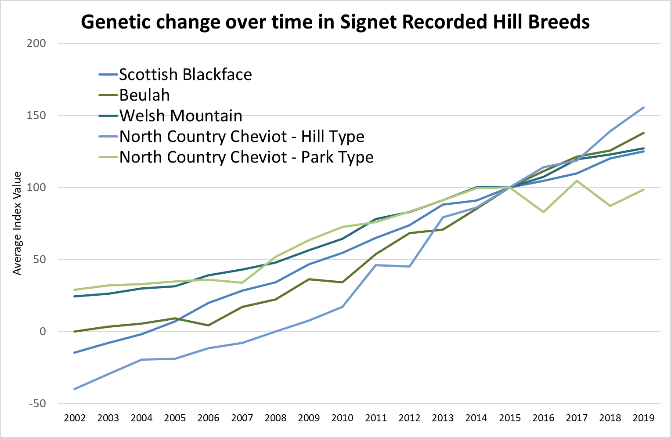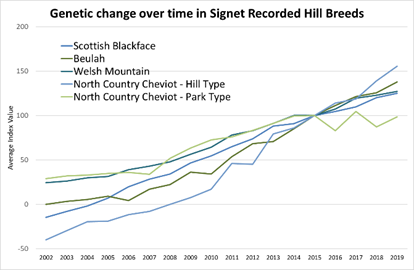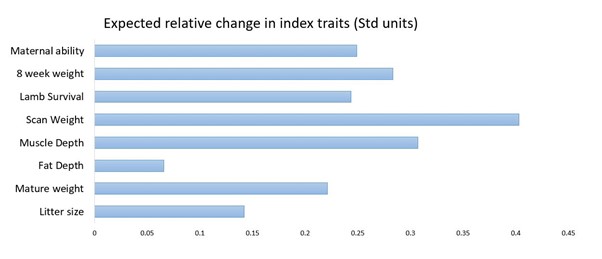Hill Sheep Breeding Index

The National Hill Sheep Breeding Evaluation

A new genetic evaluation for hill breeds
The UK has world-leading sheep genetics, with over 1,000,000 lambs recorded over the last 25 years and high rates of gain achieved in performance-recorded flocks. We have come a long way.
In 2020, a new multi-breed analysis was launched for hill breeds, benefits of the service include:
- Enhancing existing EBVs to make them more commercially focused
- Rebasing EBVs to aid interpretation by commercial ram buyers
- More regular breeding evaluations
- Updated breeding indexes
Research has also begun to create EBVs for new traits like ewe longevity.
In 2023, major developments within the Hill analysis led to the UKs first genomic breeding values were launched and the index was updated to be expressed in economic terms. From June 2023 the index will be expressed in £ as the expected annual return per ewe.
A new way of assessing muscle and fat in hill sheep
The UK sheep industry pioneered the use of ultrasound scanning to assess muscle and fat levels across the loin.
Historically, traits like muscle depth have been adjusted for age to identify lambs that lay down muscle at a certain age, regardless of weight.
Sheep with high Muscle Depth EBVs, might have achieved them in two ways:
- Being big, as genetically bigger sheep tend to have more muscle
- Having a high muscle depth, relative to their weight
Breeders can already select for growth rate, so a better approach is to assess muscling independently from growth i.e. a comparison of muscling/fatness at a fixed weight, rather than a fixed age.
Within the new evaluation, all carcase trait EBVs will be weight-adjusted, rather than age-adjusted.
Commercial context
The new approach is advantageous for commercial farmers as it will enable them to optimise muscling and finish when lambs are drawn for slaughter at a specific weight. For hill breeds this approach has a special relevance, as it means we can increase the muscularity of hill breeds without increasing ewe mature size.
Which breeds are involved?
Signet's analysis currently includes for the following breeds, North Country Cheviot Park, South Country Cheviot, North Country Cheviot Hill, Welsh Mountain, Herdwick, Rough Fell, South Welsh Mountain, Beulah, Hardy Speckle, Scottish Blackface, Swaledale, Brecknock Hill Cheviot and Black Welsh Mountain and Hebridean
A new breeding index for hill sheep
A new breeding index has been generated by Geneticist Janet Roden to aid breeders and buyers in the selection of the most profitable hill rams for commercial hill farming enterprises.
The index aims to enhance the performance of hill ewes, by:-
- Increasing lamb growth rates and carcase conformation
- Improving maternal performance in terms of milk production and maternal care
- Optimising the number of lambs reared on the hill
The new hill index aims to enhance the efficiency of hill ewes; making them more productive without increasing mature size and thus the cost of keeping them or compromising their survival or fitness in the hill environment.
So what are the index weightings in the Hill Index?
In general terms the index weightings are as follows
- Number of lambs born - Positive and Low
- Mature size (ewe weight) - Negative and Low
- Eight week weight - Positive and Moderate
- Maternal ability - Positive and Moderate
- Scan weight - Positive and Moderate
- Ultrasound muscle depth - Positive and High
- Ultrasound fat depth - Positive and Low
The raw weightings are shown below, but these mean little in isolation as traits have different heritability values and genetic correlations to each other.
Raw Index Weightings
|
Breeding Values |
Raw Index Weight |
|
Litter Size Born |
3.12883 |
| Lamb Survival |
16.76057 |
| Mature Weight |
-1.88217 |
|
8 Week Weight |
0.286134 |
|
Maternal Ability (Milk and Maternal Care) |
3.383752 |
|
Scan Weight |
4.301383 |
|
Muscle Depth |
2.972283 |
|
Fat Depth |
0.629283 |
A better way to assess the expected genetic change is to look at the relative change expected through selection. This is shown in the chart below, based on work by Janet Roden, though this diagram does assume additional selection for lamb survival which is currently work in progress and is not included in the current breeding index.
Updating existing EBVs
EBVs for lambing ease, birth weight, litter size, maternal ability and faecal egg count have all been updated using the latest research to make them more informative to commercial farmers.
EBVs and Indexes set to a 2015 base
All Estimated Breeding Values have been reset to a 2015 base, making EBV interpretation easier and more relevant to commercial ram buyers. Changes to the model mean that new, unrecorded breeding stock entering the analysis now do so with a fairer starting point.
Comparing performance between flocks
To enable the comparison of EBVs between flocks, there needs to be genetic linkage between the flocks i.e. some related sheep born in each flock. New online tools are being developed to show the degree of linkage between Signet-recorded flocks to show where comparisons can be made.
Where can I find information?
EBVs from the new analysis can be found at signetdata.com. The Signet website also provides lists of sheep that are currently for sale and access to Flock Finder, a listing of breeders that record their sheep.
How can I get involved?
Signet offers a full range of online recording services, so getting started has never been easier. Contact Signet to start recording today. Email [email protected]
A couple of videos explaining the change in expression of the index to economic terms and how genomic information is being utilised within the National Hill Breeding Evaluations
